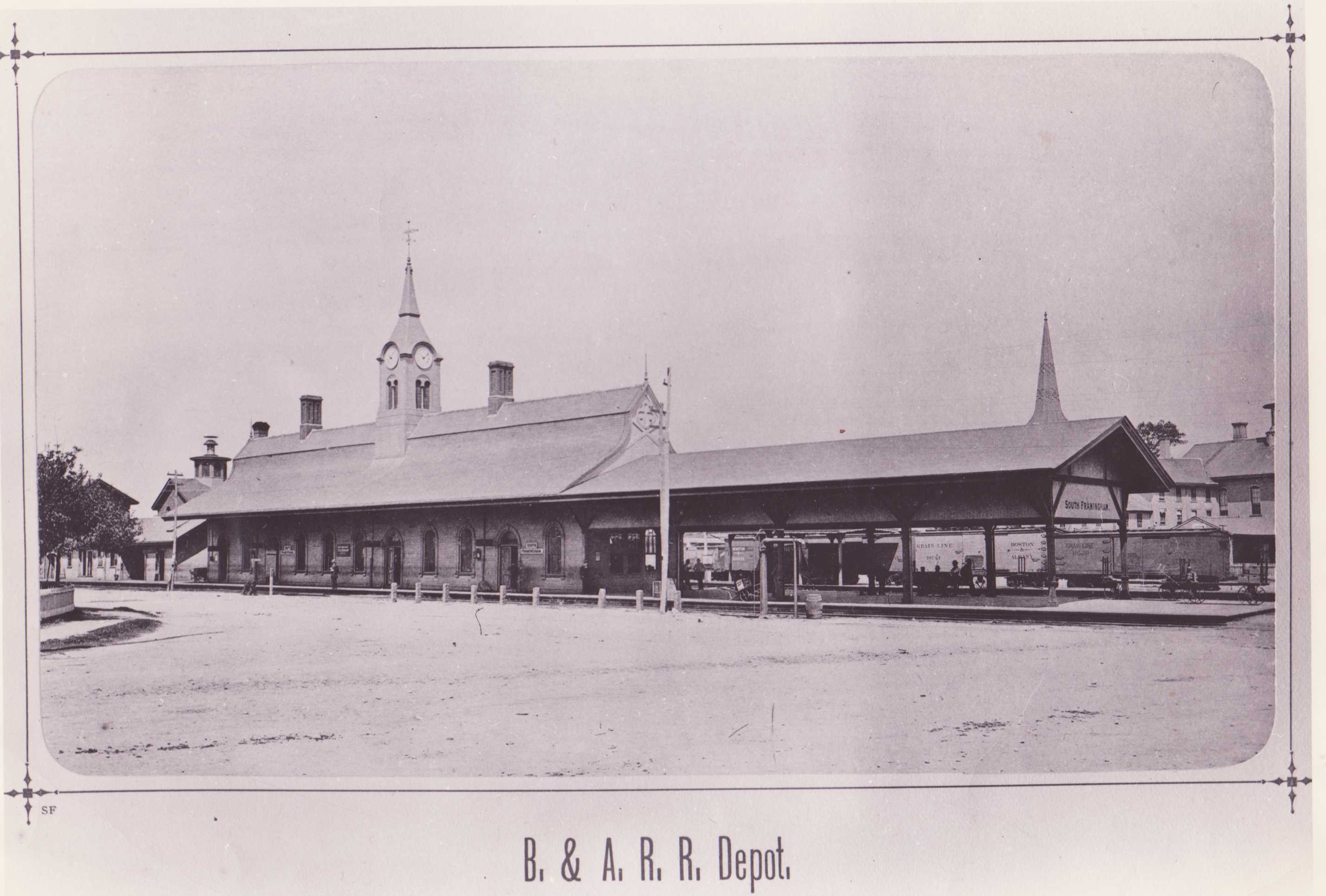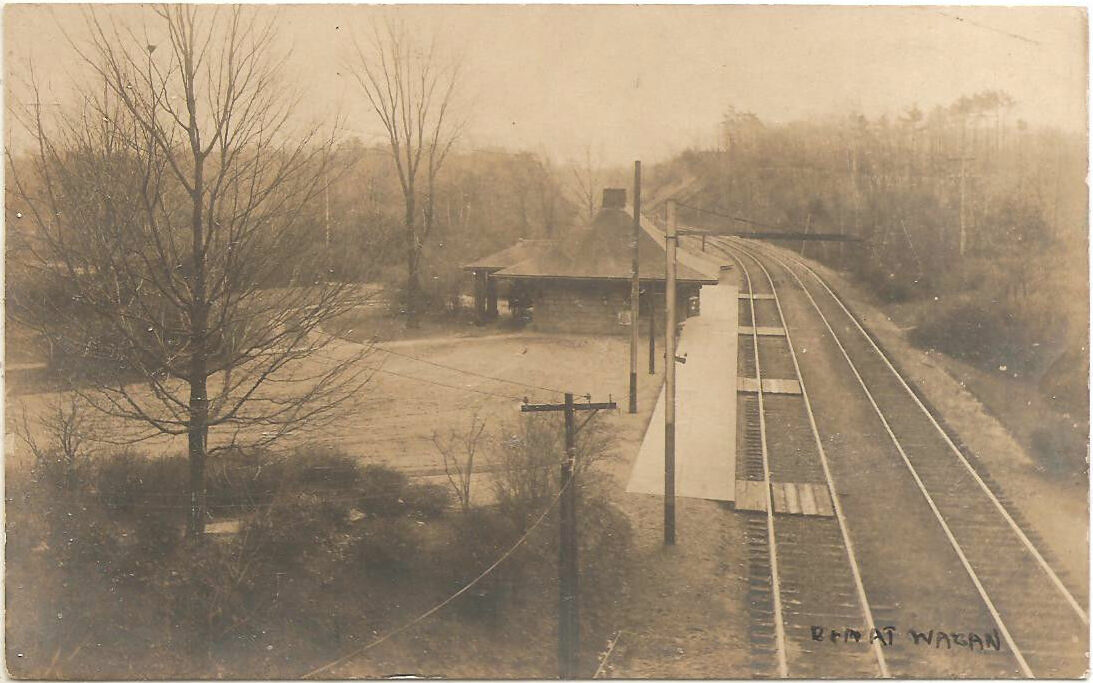|
Framingham (MBTA Station)
Framingham station is a historic Boston and Albany Railroad station located in downtown Framingham, Massachusetts. Designed by noted American architect H. H. Richardson, it was one of the last of the railroad stations he designed in the northeastern United States to be built. The station, built in 1884–85, served as a major stop on the B&A Main Line as well as a hub for branch lines to Milford, Mansfield, Fitchburg, and Lowell. After years of deterioration, the station was listed on the National Register of Historic Places in 1975 as the Framingham Railroad Station, and restored a decade later. In 2001, MBTA Framingham/Worcester Line and Amtrak operations were shifted to a new set of platforms nearby, which have high-level sections for handicapped-accessible boarding and a footbridge for crossing the tracks. This new station is among the busiest on the MBTA system, with 41 daily MBTA and 2 Amtrak trains on weekdays. The H. H. Richardson-designed station building remains large ... [...More Info...] [...Related Items...] OR: [Wikipedia] [Google] [Baidu] |
Massachusetts Route 135
Route 135 is a east-west state highway in eastern Massachusetts. The western terminus is at U.S. Route 20 in Northborough and the eastern terminus is at I-95 and Route 128 in Dedham. The first of the Boston Marathon, from Hopkinton to Wellesley, follow Route 135. Route description Route 135 begins at US 20 in Northborough. The route initially follows a southeasterly path, interchanging with Route 9 approximately from its beginning. Continuing into Westborough, Route 135 meets Route 30 at a rotary. The highway continues southeast, crossing underneath Interstate 90 and Interstate 495, but interchanging with neither. The route enters Hopkinton, and turns northeast at an intersection with West Main Street, which provides nearby access to I-495. Route 135 crosses Route 85 just to the east, then continues through Ashland and into Framingham. In downtown Framingham, Route 135 crosses Route 126. Route 135 continues into Natick and crosses Route 27 in the center of town. The ... [...More Info...] [...Related Items...] OR: [Wikipedia] [Google] [Baidu] |
Newton, Massachusetts
Newton is a city in Middlesex County, Massachusetts, United States. It is approximately west of downtown Boston. Newton resembles a patchwork of thirteen villages, without a city center. According to the 2020 U.S. Census, the population of Newton was 88,923. History Newton was settled in 1630 as part of "the newe towne", which was renamed Cambridge in 1638. Roxbury minister John Eliot persuaded the Native American people of Nonantum, a sub-tribe of the Massachusett led by a sachem named Waban, to relocate to Natick in 1651, fearing that they would be exploited by colonists. Newton was incorporated as a separate town, known as Cambridge Village, on December 15, 1681, then renamed Newtown in 1691, and finally Newton in 1766. It became a city on January 5, 1874. Newton is known as ''The Garden City''. In ''Reflections in Bullough's Pond'', Newton historian Diana Muir describes the early industries that developed in the late 18th and early 19th centuries in a series of mills b ... [...More Info...] [...Related Items...] OR: [Wikipedia] [Google] [Baidu] |
Boston, Revere Beach And Lynn Railroad
The Boston, Revere Beach and Lynn Railroad was a narrow-gauge passenger-carrying shortline railroad between East Boston and Lynn, Massachusetts, from 1875 to 1940. Part of the railroad's right of way now forms the outer section of the Massachusetts Bay Transportation Authority's Blue Line rapid transit service. History The railroad was chartered May 23, 1874, and opened July 29, 1875. A ferry connection from its southern terminus at East Boston connected to Rowes Wharf in the city of Boston proper, with a connection to the Atlantic Avenue Elevated (from 1901 to 1938). The railroad followed the coastline north-eastward through the resort of Revere Beach to the far terminus at Lynn. A branch split at Orient Heights to a loop through Winthrop. The rail laid was light, 30-pound per yard (15 kg/m) rail being installed at first, increased to 50 lb/yd (25 kg/m) in 1885 and 60 lb/yd (30 kg/m) in 1904. It was, however, laid from the beginning on standard g ... [...More Info...] [...Related Items...] OR: [Wikipedia] [Google] [Baidu] |
Third Rail
A third rail, also known as a live rail, electric rail or conductor rail, is a method of providing electric power to a railway locomotive or train, through a semi-continuous rigid conductor placed alongside or between the rails of a railway track. It is used typically in a mass transit or rapid transit system, which has alignments in its own corridors, fully or almost fully segregated from the outside environment. Third rail systems are usually supplied from direct current electricity. Modern tram systems, street-running, avoid the risk of electrocution by the exposed electric rail by implementing a segmented ground-level power supply, where each segment is electrified only while covered by a vehicle which is using its power. The third-rail system of electrification is not related to the third rail used in dual gauge railways. Description Third-rail systems are a means of providing electric traction power to trains using an additional rail (called a "conductor rail") fo ... [...More Info...] [...Related Items...] OR: [Wikipedia] [Google] [Baidu] |
New York Central Railroad
The New York Central Railroad was a railroad primarily operating in the Great Lakes and Mid-Atlantic regions of the United States. The railroad primarily connected greater New York and Boston in the east with Chicago and St. Louis in the Midwest, along with the intermediate cities of Albany, Buffalo, Cleveland, Cincinnati, Detroit, Rochester and Syracuse. New York Central was headquartered in New York City's New York Central Building, adjacent to its largest station, Grand Central Terminal. The railroad was established in 1853, consolidating several existing railroad companies. In 1968, the NYC merged with its former rival, the Pennsylvania Railroad, to form Penn Central. Penn Central went bankrupt in 1970 and merged into Conrail in 1976. Conrail was broken-up in 1999, and portions of its system were transferred to CSX and Norfolk Southern Railway, with CSX acquiring most of the old New York Central trackage. Extensive trackage existed in the states of New York, Pennsyl ... [...More Info...] [...Related Items...] OR: [Wikipedia] [Google] [Baidu] |
Massachusetts Route 126
Route 126 is a north–south state highway in Massachusetts. Its southern terminus is a continuation of Rhode Island Route 126 by Woonsocket, Rhode Island and its northern terminus is at Route 2 and Route 2A in Concord. Along the way it intersects several major routes including Interstate 495 (I-495) in Bellingham, Route 9 in Framingham, and U.S. Route 20 (US 20) in Wayland. Route description Route 126 begins at the Rhode Island state line, continuing into Woonsocket as Rhode Island Route 126. After a short stretch in the town of Blackstone and Worcester County, Route 126 enters the town of Bellingham and Norfolk County, heading north. In Bellingham, Route 126 has a short concurrency with Route 140 at the center of town. In the north of the town, the route turns east on Hartford Avenue, crossing I-495 at Exit 18. Shortly after entering the town of Medway, the route turns north again, crossing Route 109 shortly after that. Route 126 then enters Holliston, i ... [...More Info...] [...Related Items...] OR: [Wikipedia] [Google] [Baidu] |
Henry-Russell Hitchcock
Henry-Russell Hitchcock (1903–1987) was an American architectural historian, and for many years a professor at Smith College and New York University. His writings helped to define the characteristics of modernist architecture. Early life Henry-Russell Hitchcock Jr. was born in Boston, Massachusetts, on June 3, 1903, the son of Dr. Henry Russell Hitchcock, a physician and graduate of the Harvard Medical School, class of 1890, and his wife, Alice Davis. The hyphenation of the son's given names was probably an affectation. He was educated at Middlesex School and Harvard University, receiving his A.B. in 1924 and his M.A. in 1927. Educator Hitchcock taught at a number of colleges and universities, but primarily at Smith College (where he was also Director of the Smith College Museum of Art from 1949 to 1955). In 1968 he moved to New York City and thereafter taught at the Institute of Fine Arts, New York University. He also taught at Wesleyan University, Massachusetts Institute ... [...More Info...] [...Related Items...] OR: [Wikipedia] [Google] [Baidu] |
Highland Branch
The Highland branch, also known as the Newton Highlands branch, was a suburban railway line in Boston, Massachusetts. It was opened by the Boston and Albany Railroad in 1886 to serve the growing community of Newton, Massachusetts. The line was closed in 1958 and sold to the Metropolitan Transit Authority (MTA), the predecessor of the current Massachusetts Bay Transportation Authority (MBTA), which reopened it in 1959 as a light rail line, now known as the D branch of the Green Line. The first section of what became the Highland branch was built by the Boston and Worcester Railroad between Boston and Brookline in 1848. The Charles River Branch Railroad, a forerunner of the New York and New England Railroad, extended the line to Newton Upper Falls in 1852. The B&A bought the line in 1883 and extended to Riverside, rejoining its main line there. The MTA electrified the line when it rebuilt it for light rail use. The conversion of the Highland branch into a light rail line was p ... [...More Info...] [...Related Items...] OR: [Wikipedia] [Google] [Baidu] |
Framingham Railroad Station Interior 1959
Framingham () is a city in the Commonwealth of Massachusetts in the United States. Incorporated in 1700, it is located in Middlesex County and the MetroWest subregion of the Greater Boston metropolitan area. The city proper covers with a population of 72,362 in 2020, making it the 14th most populous municipality in Massachusetts. Residents voted in favor of adopting a charter to transition from a representative town meeting system to a mayor–council government in April 2017, and the municipality transitioned to city status on January 1, 2018. History Framingham, sited on the ancient trail known as the Old Connecticut Path, was first settled by a European when John Stone settled on the west bank of the Sudbury River in 1647. Native American leader Tantamous lived in the Nobscot Hill area of Framingham prior to King Philip's War in 1676. In 1660, Thomas Danforth, an official of the Bay Colony, formerly of Framlingham, Suffolk, received a grant of land at "Danforth's Farms" and ... [...More Info...] [...Related Items...] OR: [Wikipedia] [Google] [Baidu] |




.jpg)
.jpg)
